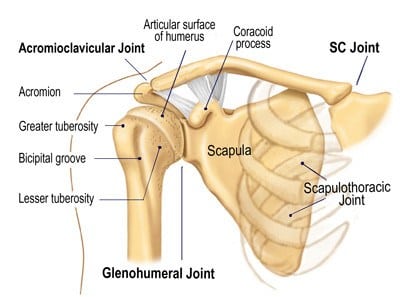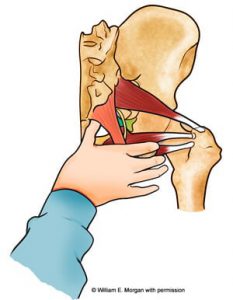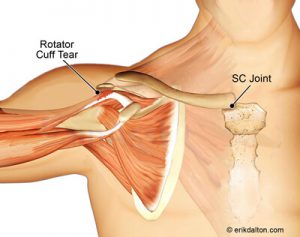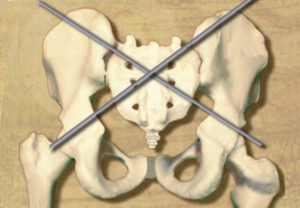Mobilization Treatment Techniques to Restore Movement
Many sessions normally begin with assessment and treatment techniques aimed at restoring length-tension balance between tonic and phasic (tight-weak) muscle groups. Typical imbalances between these two muscular systems lead to syndromes (such as Janda’s upper and lower crossed) that may alter the position and function of associated joints. Over the years, a practical joint mobilization recipe for massage and bodywork practitioners has been developed to help correct osseous fixations that reflexogenically tighten or weaken neighboring muscles setting the stage for stubborn pain/spasm/pain cycles.

Any alteration of joint function influences muscular function, thus producing a self-sustaining chain reaction. Passively stretching tight, inert capsular tissue can resolve only part of the stiff shoulder joint problem. Active motion applied frequently to the restrictive tissues reinforces available ROM gained during joint mobilization. Let me stress again that mobilization with movement is highly recommended as a mobilization treatment technique. Active movement psychologically reinforces to the client that she can move the arm through a greater range of motion. Physiologically, active movement not only assists in healing collagen tissue allowing it to align itself along normal stress lines, but also aids in restoration of normal strength. Active movement also nourishes articular cartilage and enhances repair of damaged tissues.
It is crucial that normal mechanics of the shoulder girdle and spine be understood in order to restore full range of motion to injured joints and associated soft tissues. In joint mobilization, the focus falls on arthrokinematics—motion occurring at the joint surface, instead of osteokinematics, or bone motion. Each joint within the shoulder girdle has unique arthrokinematics that contribute valuable components toward full shoulder mobility. Each specific joint motion should be considered in the evaluation of any client presenting with restricted range of motion.
In my practice, I have come to realize that many shoulder, arm and hand complaints are caused by stresses and injuries to joints. Soon protective reflex muscle guarding develops to splint the vulnerable area. Therefore, I choose to begin each upper extremity session with a quick and practical 10-minute mobilization routine followed by a thorough evaluation of possible injuries to associated soft tissues. The treatment begins with a systematic assessment of all bony articulations in the shoulder, elbow, wrist, and hand beginning with the sternoclavicular (SC) joint. This protocol allows me to identify motion-restrictions in soft tissues and joint structures simultaneously. While evaluating each joint, I look for ART:
- Asymmetry
- Restriction of Motion
- Tissue Texture Abnormalities
Therapist-assisted mobilization routines not only help identify and correct bony restrictions (and create joint-play), but also address extremity pain commonly blamed on soft tissue injuries. Of course, pelvic and trunk alignment and stabilization routines are always performed prior to upper extremity work. This necessity is painfully obvious to most structural integrators and sports therapists. For example, during a tennis serve the power generated by the shoulder must follow a kinetic chain beginning with power produced by the legs, trunk and back. Since the muscle mass of the shoulder is relatively small, if inadequate momentum is generated by the preceding links in the kinetic chain, the shoulder has to play ‘catch-up’ and generate power rather than acting as a force regulator. Improving muscle/joint function in the legs, lumbars and trunk stabilizers, allows reduction of the incidence of rotator-cuff, ligament, and joint capsule injuries.
The reflexogenic relationship of muscles and joints is at the core of the myoskeletal method. Biomechanical analysis of specific joints is not difficult and can help rule out suspected soft tissue injuries. In skilled hands joint mobilization is a crucial and effective element in injury prevention.
On sale this week only!
Save 25% off the "Dalton Technique Treasures" eCourse
The “Dalton Technique Treasures” eLearning course is a compilation of some of Erik’s favorite Myoskeletal Alignment Techniques (MAT). Learn MAT techniques to assess and address specific sports injuries, structural misalignment, nervous system overload, and overuse conditions. ON SALE UNTIL July 29th! Get Lifetime Access: As in all our eLearning courses, you get easy access to the course online and there is no expiry date.







